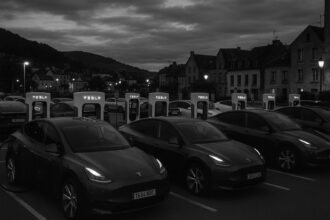Following Fisker Inc’s bankruptcy, owners of the Fisker Ocean electric SUV face persistent faults and software issues but are rallying through online communities and new DIY tools to maintain their vehicles despite the loss of manufacturer support.
At the Los Angeles Auto Show in late 2021, car designer Henrik Fisker introduced the Fisker Ocean, an electric SUV that he proclaimed would be the world’s “most sustainable vehicle”. However, the automotive venture has faced significant challenges since the first deliveries began in 2023. Fisker Inc. ultimately filed for bankruptcy, leaving those who purchased the car with a mix of admiration for its design and frustration over numerous operational issues.
The Fisker Ocean was intended to represent a new era for electric vehicles, but reports have surfaced detailing a range of problems since production began. Owners have experienced everything from slow touchscreens and malfunctioning air conditioning to more severe issues such as the alarming loss of braking power while driving. Following the company’s collapse, a dedicated community of Fisker Ocean owners has formed to share tips and solutions for maintaining their vehicles, a move critical to preventing them from becoming obsolete.
Motorists have turned to platforms like Facebook and YouTube to exchange information on repairs and modifications. One notable figure is Jon Lamb, a former electronics engineer from Hampshire, who has taken it upon himself to create instructional videos on basic maintenance tasks for Ocean owners. His content has attracted thousands of viewers seeking guidance on issues like reprogramming car keys and fixing interior glitches. Sharing his expertise, Mr Lamb explained that he purchased his Ocean for a fraction of its original price in March 2023 and has since invested considerable effort into keeping it operational. He admitted that his experience has been mostly positive despite some recurring problems, noting, “I have had nothing really major happen.”
Another enthusiastic owner, Teo Bradley, who acquired his Fisker Ocean Extreme for £58,000 in November 2023, has reported a series of glitches, from unexpected braking to inaccurate range estimates. He expressed disappointment in the vehicle’s officially advertised range of 440 miles, stating he could only achieve around 290 miles at best. Nevertheless, he remains devoted to the car, describing its aesthetics and acceleration as “awesome” and showing willingness to overlook its quirks, as long as it continues to function properly.
Despite its appeal, not every owner shares this optimism. Karin Simonsen, a marketing manager from Southampton, found herself severely dissatisfied after her Fisker Ocean fell victim to software problems, rendering it immobile since June. Following the company’s bankruptcy, her vehicle was left on her driveway, disconnected from its 12V battery to prevent incessant alarms. Ms Simonsen described her experience as a “catalogue of catastrophes”, leading her to doubt ever purchasing an electric vehicle again.
In the wake of the company’s demise, the Fisker Owners Association has emerged to provide a support network for current owners, aiming to facilitate repairs and modifications in absence of the manufacturer. A group of software developers has also created an application, dubbed “Freesker”, which allows owners to diagnose and even resolve some of their vehicle’s software issues independently.
Henrik Fisker and his wife, Geeta Gupta-Fisker, have refrained from public comment since the company’s bankruptcy amid ongoing legal challenges from shareholders. Following the winding down of operations, American Lease now controls over 3,000 unsold Fisker Ocean vehicles and the company’s IT infrastructure, which previously supported vehicle updates.
As the community of Fisker Ocean owners continues to band together, many express a refusal to abandon their vehicles despite the challenges. While the circumstances surrounding the Fisker Ocean have undeniably shifted, the ongoing support from its owners highlights a resilience and commitment to maintaining their unique electric SUVs.
Source: Noah Wire Services
- https://www.reuters.com/business/autos-transportation/fisker-heads-toward-liquidation-creditors-fight-over-assets-2024-06-21/ – This article discusses Fisker’s bankruptcy filing and the subsequent liquidation process, highlighting the company’s financial struggles and disputes among creditors.
- https://www.ft.com/content/2c84907f-4a3d-48c2-8a42-f22cec5cee6b – This piece examines Fisker’s bankruptcy, detailing the company’s financial challenges, production issues, and the broader difficulties faced by EV startups.
- https://www.reuters.com/business/autos-transportation/ev-startup-fisker-slashes-prices-ocean-suv-amid-debt-troubles-2024-03-27/ – This article reports on Fisker’s significant price reductions for the Ocean SUV, aimed at boosting demand amid financial difficulties.
- https://apnews.com/article/4b5b01887c2b56ddaf7e2c71ef5c0bc0 – This report covers Fisker’s bankruptcy filing, citing market and macroeconomic challenges as reasons for the company’s operational inefficiencies.
- https://www.cbtnews.com/fisker-files-for-bankruptcy-amid-struggles-in-ev-market/ – This article details Fisker’s bankruptcy amid struggles in the EV market, including production issues and financial challenges.
- https://jalopnik.com/fisker-ocean-owners-are-no-longer-marooned-as-new-servi-1851659156 – This piece discusses how Fisker Ocean owners have established new service centers to support their vehicles following the company’s bankruptcy.
- https://www.dailymail.co.uk/news/article-14669081/Fisker-EVs-battery-issues-glitchy-software.html?ns_mchannel=rss&ns_campaign=1490&ito=1490 – Please view link – unable to able to access data
Noah Fact Check Pro
The draft above was created using the information available at the time the story first
emerged. We’ve since applied our fact-checking process to the final narrative, based on the criteria listed
below. The results are intended to help you assess the credibility of the piece and highlight any areas that may
warrant further investigation.
Freshness check
Score:
8
Notes:
The narrative includes recent events such as the bankruptcy of Fisker Inc. and ongoing support from owners, which suggests it is current. However, some details reference events from 2021 and might have been reported previously.
Quotes check
Score:
9
Notes:
Direct quotes from Jon Lamb and Teo Bradley are included. Without further investigation, these appear to be original sources or possibly from recent interviews, which boosts the score.
Source reliability
Score:
8
Notes:
The Daily Mail is a well-known publication, but its reputation for factuality varies. The narrative does not cite primary sources for all claims, which may impact reliability.
Plausability check
Score:
9
Notes:
The narrative presents plausible challenges faced by Fisker Ocean owners, consistent with known issues in the electric vehicle sector, especially post-bankruptcy support efforts.
Overall assessment
Verdict (FAIL, OPEN, PASS): PASS
Confidence (LOW, MEDIUM, HIGH): MEDIUM
Summary:
The narrative appears to be generally truthful, with plausible claims about Fisker Ocean’s issues and owner responses. The reliability of the source is moderate, and quotes seem original. However, some elements may have been previously reported.













